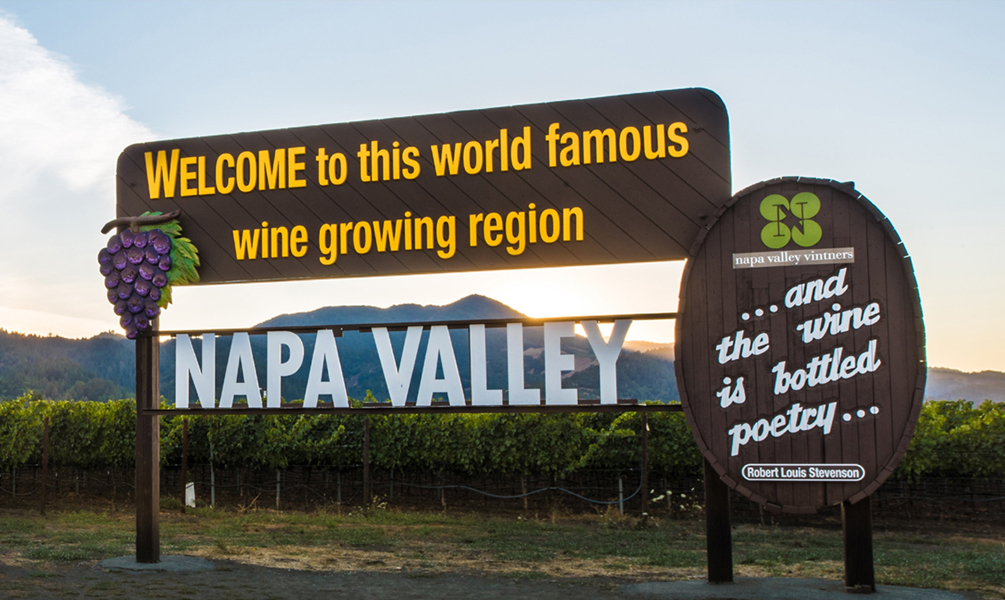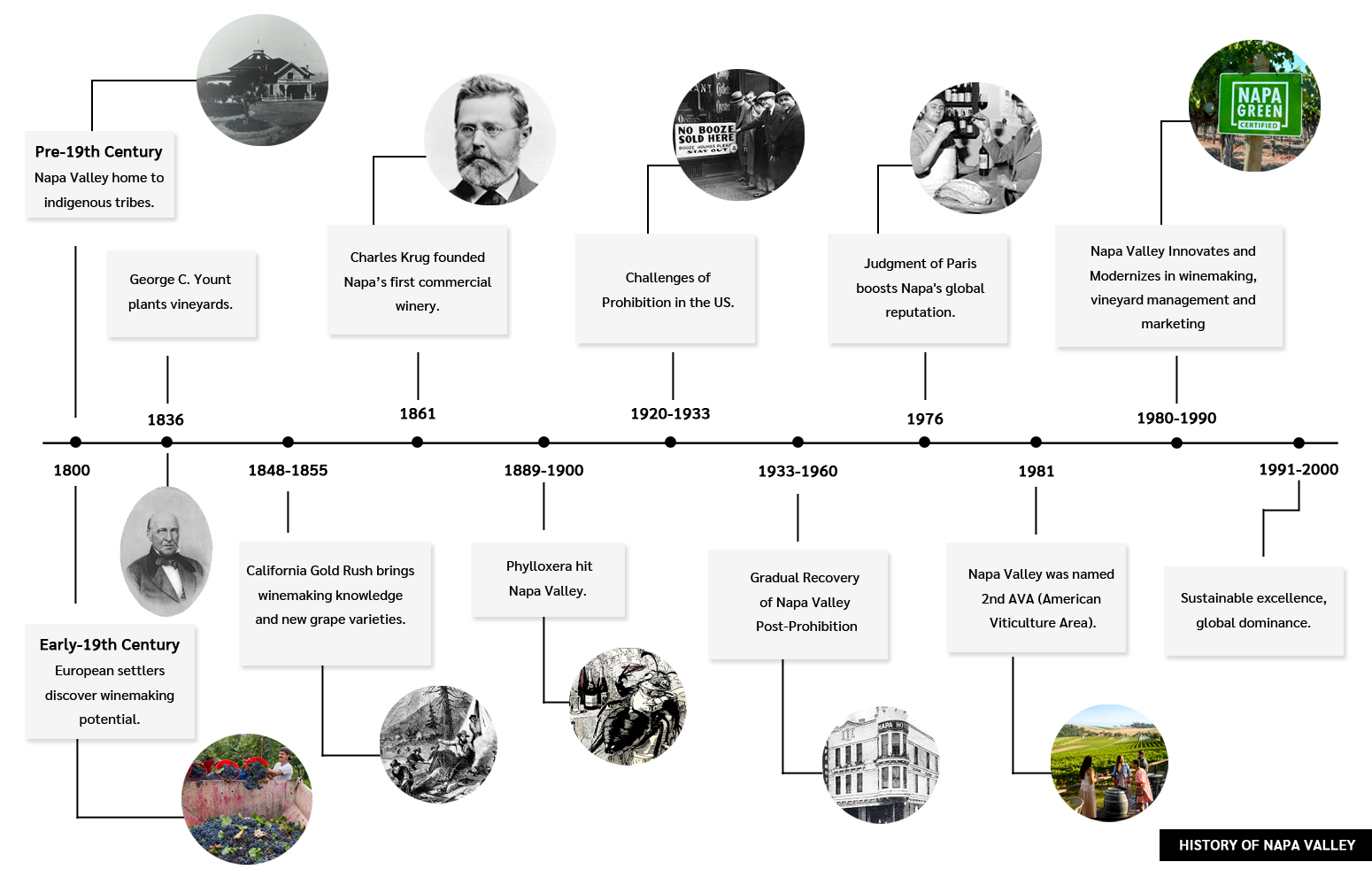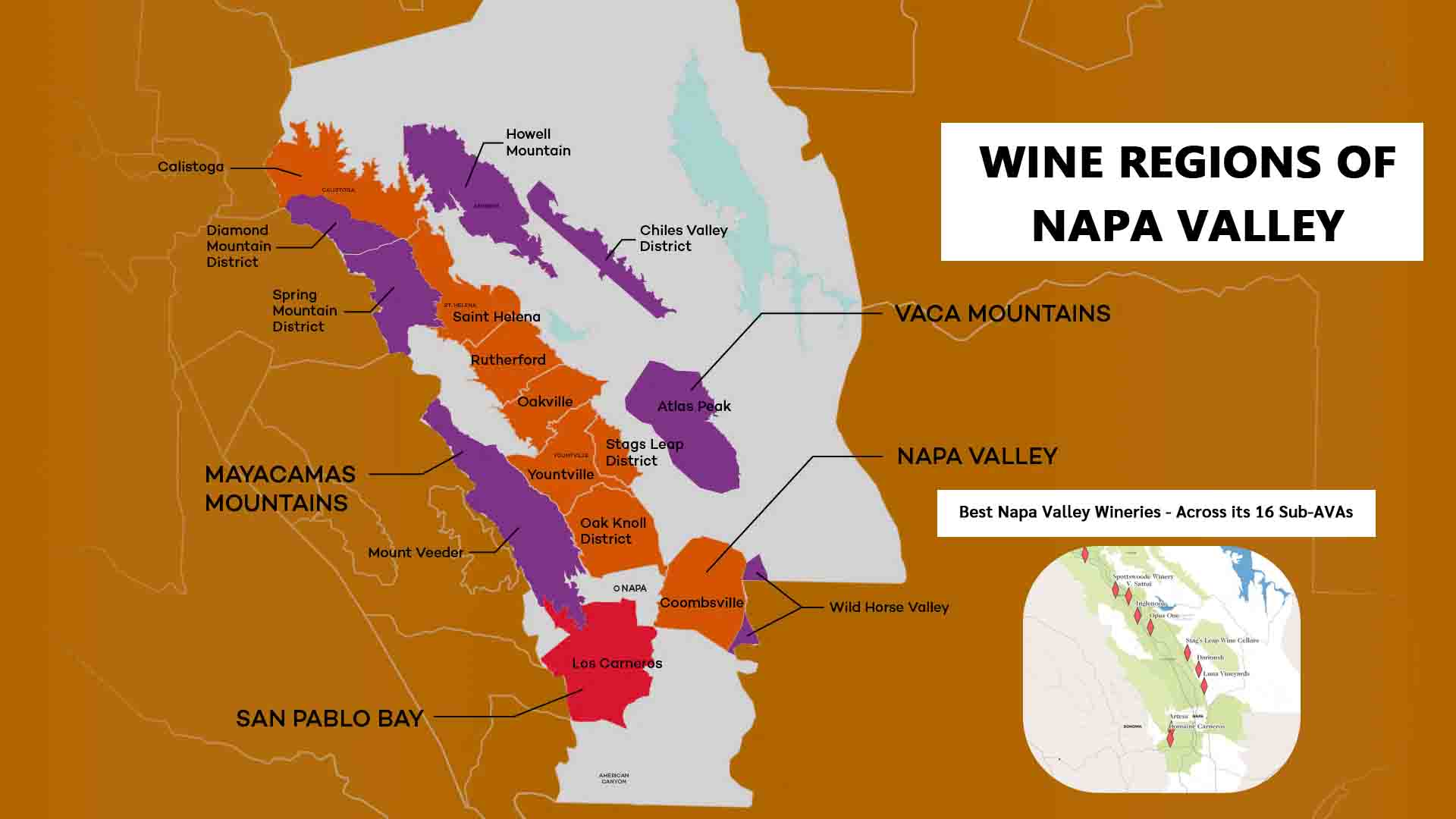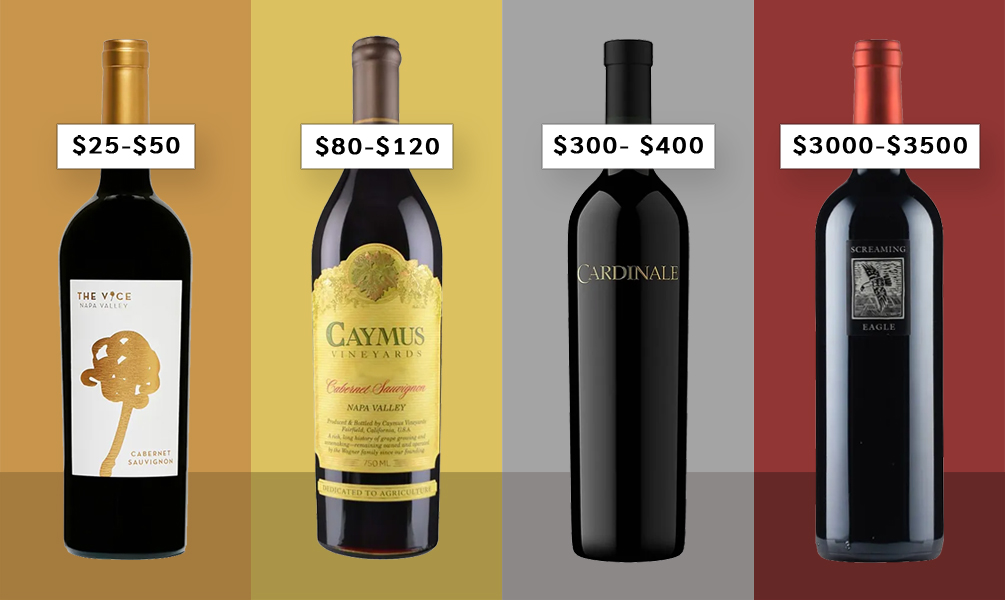
How about I hand you a pushpin and ask you to pinpoint a spot on a world map that, in your eyes, is a literal hotspot for the world's finest wines? I can’t speak for your vinous judgment, but my focus would undoubtedly be on one place: Napa Valley. Nestled in the heart of California, this wine region is a scenic, lush paradise with a rich history that has stood the test of time.
Today, Napa remains peerless, known for its exceptional terroir, craftsmanship, and trailblazing spirit. Every dawn in Napa brings the wine world a renowned sense of hope and a promise of redefining what can be the best in luxury wine, wine tourism, and beyond. Whether you’re thinking from a global, American, or California perspective, it continues to shine apart.
If you’re eager to explore Napa Valley and the best it has to offer, you’re in the right place! We've written a complete guide to Napa Valley, layered enough to make your go-to club sandwich shy. So get ready for this oenological adventure, uncovering everything from Napa's history to terroir features, top wineries, prolific grape varieties, and top Napa Valley wines, along with hot tips on choosing the best Napa wine, storing it, and serving it with confidence.
This Napa Valley Wine Blog Covers:
- Brief History of Napa Valley
- What Makes Napa Valley’s Terroir So Exceptional?
- Best Napa Valley Wineries - Across its 16 Sub-AVAs
- Top Grape Varieties of Napa Valley - Cult Cabernet Sauvignon & More
- Are Napa Wines Expensive?
- How to Store Napa Valley Wines?
- Serving Suggestions for Napa Valley Wines
Brief History of Napa Valley

For millennia, Napa was home to the indigenous Wappo and Patwin tribes, and it wasn’t until the 19th century that European settlers, drawn to the land for farming and ranching, discovered its winemaking potential and began harvesting mission grapes to produce sacramental wines.
In the mid-1800s, when the fever of the California Gold Rush was high, the population boom benefited the region with wide winemaking knowledge and new grape varieties. Vineyards were first planted by George C. Yount in 1836, and wineries were established, notably by Charles Krug in 1861.
But it wasn’t until the 1976 Judgment of Paris, a landmark blind tasting where wines by Stags’ Leap Wine Cellars and Chateau Montelena outperformed French wines, that Napa Valley entered the global wine map. This judgment was historic, igniting a global obsession with Napa wines like wildfire. So much so, today, Napa Valley boasts around 475 wineries, each fueled by the passion to produce world-class, critically acclaimed wines.
As a cherry on top, Napa is leading the charge in sustainability, reflecting its forward-thinking approach to tackling modern challenges and securing a brighter future in the wine industry.
What Makes Napa Valley’s Terroir So Exceptional?
With such a quick peek into Napa’s history, it is clear that this region has always been passionate about exceptional winemaking. But what gave Napa the confidence to excel in this craft from the start? The answer lies in its ultra rich, rare terroir that produces vines of extraordinary caliber.
- Terrain: Napa Valley, situated east of Sonoma County and south of Lake County, is sandwiched between two mountain ranges. These ranges contribute to diverse topography, featuring elevations, slopes and landforms that guard vineyards from extreme temperatures. The Vaca Range to the east protects from Central Valley heat , while the Mayacamas to the west blocks influences from the Pacific Ocean.
- Climate: Climate: Napa Valley’s dry Mediterranean climate is a rare feature, found in only 2% of the world. This climate is best defined as moderate, with minimal rainfall fluctuations, making it ideal for grape cultivation. Furthermore, dramatic climatic fluctuations across the region's 30-mile stretch provide diverse growing conditions, warming as one travels north from the cooling fog of San Pablo Bay.
- Soil: The Valley boasts a breathtaking diversity of 33 soil types, including maritime, clayey, volcanic and alluvial soils, all contributing to the region’s viticultural diversity.
Best Napa Valley Wineries - Across its 16 Sub-AVAs

Doubtlessly, nature has favored the Napa Valley with an incredibly diverse terroir that’s jaw-droppingly rare. To ensure the region’s nuances do not go unnoticed, it’s divided into 16 sub-AVAs, each showcasing unique terroir differences, even between those in close proximity. This web of subregions scatters the wineries, and each winery's wines are distinct expressions of the sub-AVAs from which they source their grapes.
Napa Valley’s subregions can be categorized into valley, mountain, and bay areas, each grouping a few subregions with common characteristics. Here’s a list of the 16 sub-AVAs of Napa Valley, along with the best wineries within them.
Napa Valley’s subregions can be categorized into valley, mountain, and bay areas, each grouping a few subregions with common characteristics. Here’s a list of the 16 sub-AVAs of Napa Valley, along with the best wineries within them.
-
Valley Regions - Features moderate temperatures, varied microclimates, and deeper alluvial and fluvial soils with an annual rainfall of 35–55 inches. End result: elegant to robust-styled wines.
|
S.NO. |
SUB-AVAs |
BEST NAPA VALLEY WINERIES |
| 1. | Oak Knoll District | Trefethen Family, Darioush Winery, Monticello |
| 2. | St. Helena | Duckhorn, Hall, J. Lohr, Louis M. Martini |
| 3. | Coombsville | Meteor, Failla, Palmaz |
| 4. | Oakville | Far Niente, Screaming Eagle, Groth, Nickel & Nickel, Opus One, Silver Oak, Bond, Promontory |
| 5. | Yountville | Domaine Chandon, Cliff Lede, Jessup |
| 6. | Stags Leap District | Chimney Rock, Clos Du Val, Stags’ Leap |
| 7. | Calistoga | Sterling, Eisele, Castello di Amorosa |
| 8. | Rutherford | Caymus, Cakebread Cellars, Inglenook, Hewitt |
-
Mountain Regions - The region boasts cooler temperatures at higher elevations, well-draining shallow, rocky, alluvial, and volcanic soils, and receives an annual rainfall of 35–55 inches. This stresses vines, resulting in wines with intense fruit flavors, structured tannins, and vibrant acidity.
| 9. | Mount Veeder | Hess Collection Winery, Mayacamas, Mount Veeder |
| 10. | Atlas Peak | Antica, Stagecoach, Acumen |
| 11. | Spring Mountain | Pride Mountain, Newton, Smith-Madrone |
| 12. | Diamond Mountain District | Diamond Creek, Reverie, Volker Eisele |
| 13. | Howell Mountain | Dunn, O'Shaughnessy, La Jota |
| 14. | Chiles Valley | Green & Red, Nichelini, Brown Estate |
-
Bay Regions -This region's close proximity to San Pablo Bay brings cooler maritime influences. Clay-rich soils retain water, contributing to wines with lively acidity, refined aromatics, and balanced fruit profiles.
| 15. | Los Carneros | Domaine Carneros, Rombauer, Etude |
| 16. | Wild Horse Valley | Lagier Meredith, Sky, The Napa Hills |
Apart from offering top-tier wines, most of these wineries are memorable tourist spots, providing warm hospitality amid picturesque views. Visitors can enjoy informative tasting tours, winery tours, culinary experiences, luxurious spas, and other fun experiments like hot air balloon rides, biking through vineyards, and more.
Whether you’re a wine lover or a hard-core traveler, experiencing Napa Valley firsthand is a must. If you’re lucky, you might even partake in wine-related events and festivals like May’s Bottlerock Napa Valley and June’s Napa Valley Wine Auction.
Top Grape Varieties of Napa Valley - Cult Cabernet Sauvignon & More
Though Napa Valley is famed for its prodigious cabernet sauvignon wines, it also offers many surprises for wine lovers seeking varieties off the beaten path. With more than three dozen different wine grape varieties cultivated in the region, here are some of the most notable:
-
Cabernet Sauvignon: Cabernet Sauvignon is almost synonymous with the Napa Valley, making up 60% of its vineyards. This variety thrives in warmer areas, offering a diverse expression across subregions. Hillside Napa Cabernet yields robust, full-bodied wines with concentrated flavors, rich tannins, and deep color, while valley-floor vineyards produce medium-bodied cabernets with mellower tannins and less concentrated flavors. Napa Cabernet is known for its stellar balance, oak nuance, structure, freshness, depth of dark fruit flavors and age-worthiness (15-30 years).
-
Chardonnay:If Cabernet is the queen of Napa reds, Chardonnay is the queen of whites. It is the second most planted grape variety, covering 7,300 acres. It thrives best in calcium-rich soils and cooler areas like Carneros and the southern Napa Valley, where slow ripening leads to balanced acidity and rich flavors. Napa Chardonnays vary from crisp to rich and buttery, influenced by harvest and winemaking practices like lees stirring and malolactic fermentation. Though best enjoyed young, Napa chardonnays can also age beautifully in your cellar for 5-15 years.
-
Merlot: Originally a blending partner for cabernet, Merlot gained recognition as a monovarietal wine due to Napa's ideal climate.This climate knots warm days with cool nights, letting grapes ripen evenly and gain rich, concentrated flavors. Napa merlots are known for their smoothness and dark fruit flavors, complemented by hints of chocolate, mocha, and herbs. They feature soft tannins and moderate acidity, making them approachable when young but capable of deepening in complexity and depth over 5-15 years.
-
Pinot Noir: Pinot Noir wines are crowd-pleasers, but the grape is challenging due to its thin skins and sensitivity to growing conditions. In Napa, Pinot Noir finds its renaissance! It’s the third most-planted red grape, crafted in cooler regions for still and sparkling styles. Napa offers one-of-a-kind Pinot Noirs with bursts of red fruits, silky tannins, and mild acidity. Depending on the winemaking approach, intensity varies. We recommend enjoying fine Pinot Noirs when they are young, even though they age well for 3-10 years.
-
Sauvignon Blanc: Sauvignon Blanc grabs attention with its herbaceous, grassy notes, vibrant acidity, and multifaceted fruit character. In Napa, cooler regions embrace the variety, creating standout best Sauvignon Blancs with elevated aromatic intensity and bright, zesty flavors like lemon, lime, green apple, pineapple, and grapefruit. While oak-aging or blending with the Sémillon grape typically boosts depth and creaminess, stainless steel fermentation typically preserves the wine's freshness. Best sipped young!
-
Zinfandel:Superbly adaptable, Zinfandel is another red grape that enhances Napa’s reputation. It develops intense flavors and fully ripens in warmer regions, as evidenced by its high alcohol content. The wine offers diverse styles—from bright and fruity to bold and full-bodied—as some winemakers aim to secure the purity of fruit flavors, while others wish to add oaky elements or blend it with varieties like Petite Sirah or Carignan to boost balance. While Napa Zinfandels are best enjoyed young, you can age them for 3-7 years to soften tannins or mature.
These are the most widely planted grape varieties in the Napa Valley. And yes, the list goes on with small plantings like Tempranillo, Albarino, and Grenache, as numerous winemakers are bucking tradition and cultivating less common and sometimes downright obscure varieties alongside more traditional ones in their vineyards.
Best Napa Valley Wines - Our 15 Pourfect Picks!
Before we uncover the Best Napa Valley Wines for you, did you know that California accounts for 90% of America's wine production, of which only 4% comes from Napa? This is full proof of how each Napa Valley red wine or white wine you discover is the epitome of quality over quantity.
List of Best Napa Valley Red Wines:
Napa Valley quite literally throws shade with its fine red wines, among which cabernets stand as the most prolific. Here is a list of the top Napa Valley red wines, handpicked just for you.
- Caymus Vineyards Cabernet Sauvignon Red Wine
- Opus One Red Wine
- Stags’ Leap Cabernet Sauvignon Red Wine
- Joseph Phelps Insignia Red Blend
- Rombauer Zinfandel Red Wine
- Far Niente Cabernet Sauvignon Red Wine
- Harlan Estate Proprietary Red Wine
- Silver Oak Napa Valley Cabernet Sauvignon
- Screaming Eagle The Flight 2019 Red Wine
List of Best Napa Valley White Wines:
From the feverish world of bold reds, let's move to the tender whites, having the throne ruled by chardonnays. Here is the list of the top white Napa Valley wines, each thoughtfully chosen:
- Rombauer Chardonnay White Wine
- The Vice Napa Valley Sauvignon Blanc 2022
- Cakebread Cellars Chardonnay White Wine
- Quilt ThreadCount Sauvignon Blanc White Wine
Napa is renowned for its Best Napa Cabernet Sauvignons, as well as its Chardonnays, but there's so much more to discover. Step out of your comfort zone and explore lesser-known blends and varieties like Sauvignon Blanc and Zinfandel—they might become your new favorites.
Are Napa Wines Expensive?

Often perceived as expensive compared to other regions, Napa Valley wines justify their high prices by prioritizing quality over quantity. This approach leads to limited production and feverish global demand, underscoring the collectible value of the best Napa Valley wines.
Napa Cabernet Sauvignon is the most expensive variety due to its reputation and high demand. Prices can range from an average of $108 per bottle to several hundred dollars for top wineries. For instance, Screaming Eagle or Harlan Estate wines can cost around $1000 per bottle due to their gold-like rarity.
Chardonnay is the next most sought-after variety, costing $40–$80, with top producers like Rombauer pricing over $100. Napa’s Merlot and Pinot Noir also come at higher prices, ranging from $40 to over $100, depending on the producer and vineyard. In contrast, Napa Zinfandel and Napa Sauvignon Blanc offer more affordable options, allowing for enjoyment without the higher costs associated with other varieties.
Napa Valley wines offer a wide range of tastes and budgets, providing both luxury and affordable options for both enthusiasts and casual drinkers. Enjoy the prestige of premium wines or explore more budget-friendly options from respected producers and lesser-known varieties.
How To Store Napa Valley Wines?
Once you find a wine you love, especially a Napa wine that can age gracefully, it’s important to store it properly to preserve its quality and enhance its characteristics over time. Here are some best practices to keep in mind when storing a bottle of Napa wine:
-
Place: Store the bottle in a cool, dark place. A dedicated wine cellar is ideal but a closet or pantry away from sunlight and vibrations can also work. Uv rays can negatively impact the wine, while vibrations can disturb the wine’s sediment.
-
Position: Store the bottle horizontally to keep the cork moist. This prevents air from seeping in through dried cork, which can lead to spoilage through “oxidation”.
-
Temperature: Maintain a consistent temperature between 55-60°F (13-15°C). Extreme fluctuations can damage the wine’s flavor and aging potential.
-
Humidity: Maintain humidity levels around 50-70% to prevent the cork from drying out and to guard the wine from spoilage.
What happens if you ever find yourself with an unfinished, opened bottle of Napa wine? Check out our recent blog: How To Store an Open Bottle Of Wine?
Serving Suggestions for Napa Valley Wines:
Serving your Napa wine properly can enhance the drinking experience and allow you to fully appreciate the wine’s complexity and character. To serve a wine like a connoisseur, follow these guidelines:
-
Temperature: Wine is best savored when chilled, as the flavor and aromas get enhanced. Serve whites like Chardonnay and Sauvignin Blanc chilled between 50-55°F (10-13°C), while reds such as Cabernet Sauvignon and Merlot are slightly cooler than room temperature, around 60-65°F (15-18°C).
The best way to chill wine is to place it in a bucket of ice and water for about 20–30 minutes. Alternatively, you can refrigerate it for a couple of hours. -
Decanting: Decanting can make red wines more expressive and delightful to drink by allowing them to breathe, opening up their flavors and aromas, and separating any sediment that may have accumulated during aging. We recommend decanting Napa Valley red wines for at least 30 minutes to an hour before serving.
-
Glassware: Glassware isn’t just show business; it enhances the wine’s aromas and flavors. For Napa red wines, choose larger, rounder bowl glasses to let them breathe, and narrower, smaller bowl glasses for white wines to preserve their delicate aromas. For high-quality glassware options, check out our glassware collection today!
-
Food pairing: Pairing wine with complementary food can elevate any dining experience. Choose meals that best complement the wine’s profile. For quick pairings, check out our collection of Napa Valley Wine Gifts, featuring top Napa wines paired with gourmet baskets of cheese, chocolates, crackers, sausages, and more.
Final Thoughts
We trust you've enjoyed delving into this comprehensive guide on Napa wines, uncovering their rich history, diverse terroirs, and the craftsmanship behind every bottle. Whether you're eager to explore Napa wines firsthand or looking for the perfect gift, we're here to help.
Our extensive collection features not only top Napa Valley wines but also curated pairings with food, accessories, glasses, and personalized options. Enjoy hassle-free delivery across the entire USA, making it simple to indulge yourself or treat loved ones today.
Cheers! ✨




















Leave a Comment